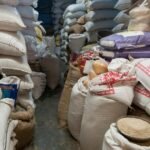OVERVIEW
The market for manufactured soils is expected to reach USD 9.75 billion by 2025, rising from 2020 to 2025 at a CAGR of 5.75%. This market’s growth is due to increasing demand for organic products, increasing global population, increased yield & productivity, and increasing trend toward modern farming practices such as regulated agriculture and urban agriculture.








TABLE OF CONTENT
1 Global Manufactured Soil (Soil Blends & Mixes) Market
1.1 Study Objectives
1.2 Market Definition
1.3 Study Scope
1.3.1 Markets Covered
1.3.2 Geographic Scope
2 RESEARCH METHODOLOGY
2.1 Research Data
2.1.1 Secondary Data
2.1.1.1 Key Data From Secondary Sources
2.1.2 Primary Data
2.1.2.1 Key Data From Primary Sources
2.1.2.2 Key Industry Insights
2.1.2.3 Breakdown of Primaries
2.2 Market Size Estimation
2.2.1 Bottom-Up Approach
2.2.2 Top-Down Approach
2.3 Market Breakdown and Data Triangulation
2.4 Research Assumptions
3 Global Manufactured Soil (Soil Blends & Mixes) Market – Executive Summary
3.1 Market Revenue, Market Size and Key Trends by Company
3.2 Key Trends by type of Application
3.3 Key Trends segmented by Geography
4 Global Manufactured Soil (Soil Blends & Mixes) Market – Comparative Analysis
4.1 Product Benchmarking – Top 10 companies
4.2 Top 5 Financials Analysis
4.3 Market Value split by Top 10 companies
4.4 Patent Analysis – Top 10 companies
4.5 Pricing Analysis
5 Global Manufactured Soil (Soil Blends & Mixes) Market – Industry Market Entry Scenario
5.1 Regulatory Framework Overview
5.2 New Business and Ease of Doing business index
5.3 Case studies of successful ventures
5.4 Customer Analysis – Top 10 companies
6 Global Manufactured Soil (Soil Blends & Mixes) Market – Market Forces
6.1 Introduction
6.2 Market Dynamics
6.2.1 Drivers
6.2.2 Opportunities
6.2.3 Challenges
6.3 Porters Analysis of Market
6.3.1 Bargaining power of suppliers
6.3.2 Bargaining powers of customers
6.3.3 Threat of new entrants
6.3.4 Rivalry among existing players
6.3.5 Threat of substitutes
7 Global Manufactured Soil (Soil Blends & Mixes) Market – Strategic Analysis
7.1 Value Chain analysis
7.2 Product Life Cycle
7.3 Supplier and distributor analysis (Market share and product dealing strategies)
8 Global Manufactured Soil (Soil Blends & Mixes) Market – By Type (Market Size – &
million/billion)
8.1 Garden soil
8.2 Soil Mix
8.3 Manure & compost
8.4 Others
9 Global Manufactured Soil (Soil Blends & Mixes) Market – By Material Input
9.1 Soil
9.2 Compost
9.3 Sand
9.4 Vermiculite
9.5 Coir fiber
9.6 Perlite
9.7 Others
10 Global Manufactured Soil (Soil Blends & Mixes) Market – By Application
10.1 Cultivation
10.2 Lawns
10.3 Commercial developments
10.4 Sports fields
10.5 Green spaces
11 Global Manufactured Soil (Soil Blends & Mixes) Market – By Geography (Market Size – &
million/billion)
11.1 Introduction
11.2 North America
11.2.1 US
11.2.2 Canada
11.2.3 Mexico
11.3 Europe
11.3.1 U.K
11.3.2 Germany
11.3.3 Italy
11.3.4 France
11.3.5 Spain
11.3.6 Rest of Europe
11.4 Asia-Pacific
11.4.1 China
11.4.2 Japan
11.4.3 India
11.4.4 South Korea
11.4.5 Rest of APAC
11.5 Rest of the World
11.5.1 South America
11.5.2 Middle East
11.5.3 Africa
12 Global Manufactured Soil (Soil Blends & Mixes) Market – Entropy
12.1 New product launches
12.2 M&A’s, collaborations, JVs and partnerships
13 Global Manufactured Soil (Soil Blends & Mixes) Market Company Profile (Key Players)
13.1 Market Share, Company Revenue, Products, M&A, Developments
13.2 The Scotts Miracle-GRO Company
13.3 Boxley Materials Company, Inc.
13.4 Casella Organics, Inc.
13.5 Tim O’hare Associates LLP
13.6 Peaceful Valley Farm & Garden Supply
13.7 Jiffy International as
13.8 Boughton Loam & Turf Management Limited
13.9 London Rock Supplies Limited
13.10 Resource Management, Inc. (RMI)
13.11 B.D. White Top Soil Company Inc.
13.12 Company 11 & more
14 Global Manufactured Soil (Soil Blends & Mixes) Market – Appendix
14.1 Sources
14.2 Abbreviations












